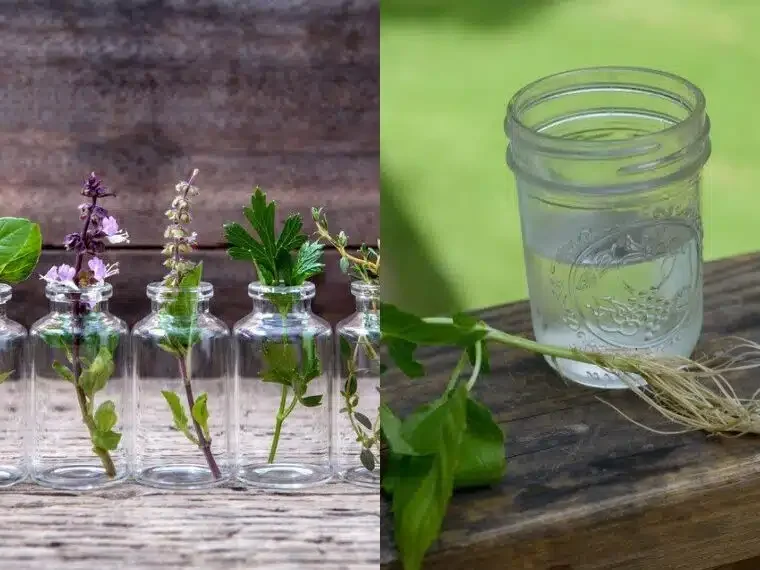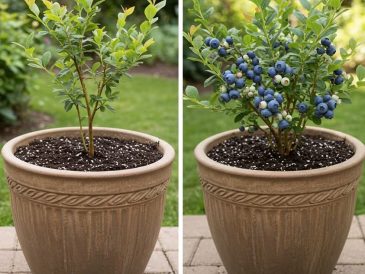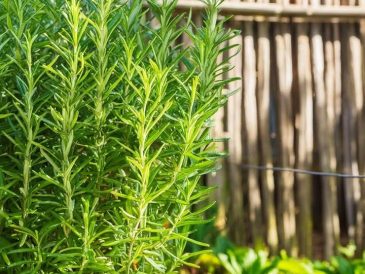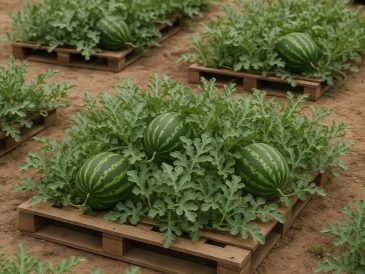Growing fresh herbs doesn’t have to involve soil, fertilizer, or complicated gardening setups.
In fact, you can grow a surprising number of culinary and medicinal herbs using nothing but water – right on your kitchen windowsill.
Whether you’re short on space, living in an apartment, or simply want an easy way to have fresh herbs year-round, water propagation (also called hydroponic herb growing) is a simple, low-maintenance solution that anyone can master.
Why Grow Herbs in Water?
Growing herbs in water isn’t just a trendy gardening hack – it’s an ancient and highly effective method that mimics how many plants naturally propagate in the wild.
For centuries, gardeners and herbalists have used water to root cuttings, keep fresh herbs alive longer, and grow plants indoors without soil.
Here’s why you might want to try it:
1. Low Maintenance and Beginner-Friendly
No weeding, no soil, no fertilizer, no mess – just water. This makes water gardening perfect for beginners or those who don’t have the time or space for a traditional garden.
2. Grow Herbs Indoors Year-Round
Even in the middle of winter, you can have a thriving herb garden indoors with consistent light and water.
3. Continuous Harvest
Because herbs keep growing as long as they have water, light, and nutrients, you can harvest fresh leaves for months – or even years.
4. Cost-Effective
You don’t need pots, soil, or special equipment. A glass jar or recycled container and some fresh water are often all you need.
5. Eco-Friendly
Growing herbs in water reduces waste (no potting soil or fertilizer runoff) and allows you to reuse kitchen cuttings and trimmings that would otherwise go in the trash.
How to Grow Herbs in Water: Step-by-Step
Before we get into the list of herbs, let’s quickly cover the basics of how to grow them successfully in water.
4. Place in Bright, Indirect Light
Most herbs thrive near a south- or east-facing window where they get plenty of indirect sunlight. Avoid direct harsh afternoon sun, which can overheat the water and damage tender roots.
5. Change the Water Regularly
Change the water once a week to prevent bacteria growth and replenish oxygen. Rinse the roots gently if algae or slime appears.
6. Harvest Often
Frequent harvesting encourages bushier growth. Pinch back stems regularly, but always leave at least one-third of the plant intact so it can keep growing.
12 Herbs You Can Grow in Water All Year Round
Now, let’s dive into the stars of this method – 12 easy, rewarding herbs that thrive in water.
1. Basil (Ocimum basilicum)
Why it’s perfect for water growing: Basil is one of the fastest and easiest herbs to root in water. It starts producing roots within a week and can thrive for months indoors.
How to grow:
- Take a 4-inch cutting from a healthy basil plant, just below a leaf node.
- Place it in a jar of water in a sunny windowsill (at least 6 hours of light per day).
- Change the water weekly.
Tips for success:
- Harvest regularly to encourage branching.
- Avoid letting flowers form – this diverts energy from leaf production.
- Basil prefers warmth, so keep it away from cold windowsills in winter.
Uses: Fresh basil is perfect for pesto, tomato sauces, salads, infused oils, and herbal teas.
2. Mint (Mentha spp.)
Why it’s perfect: Mint is nearly indestructible and grows quickly in water, making it ideal for beginners.
How to grow:
- Take a 4- to 5-inch cutting from a healthy stem, remove the lower leaves, and place it in water.
- Keep it in indirect sunlight – too much direct light can scorch the leaves.
Tips for success:
- Change water often; mint is sensitive to stagnation.
- Pinch back regularly to keep it bushy and prevent legginess.
Uses: Mint is excellent for teas, desserts, cocktails (like mojitos), sauces, and refreshing infused waters. It’s also known for soothing digestion and freshening breath.
3. Oregano (Origanum vulgare)
Why it’s perfect: Oregano is a Mediterranean herb that adapts well to water propagation and retains its strong flavor.
How to grow:
- Snip a 5-inch cutting and strip the lower leaves.
- Keep the jar in a sunny location with 6+ hours of light daily.
Tips for success:
- Harvest stems before flowering for the best flavor.
- Add a few drops of liquid seaweed fertilizer to the water once a month for long-term growth.
Uses: Perfect for Italian, Greek, and Mexican dishes, oregano also has antibacterial and immune-boosting properties.
4. Thyme (Thymus vulgaris)
Why it’s perfect: Thyme is a hardy herb that roots well in water and keeps producing for months.
How to grow:
- Take a 3- to 4-inch cutting, remove the lower leaves, and place it in water.
- Place in a sunny window (at least 6 hours of light).
Tips for success:
- Trim regularly to prevent woody growth.
- Keep the water shallow – thyme doesn’t like soggy conditions.
Uses: Thyme pairs beautifully with roasted meats, soups, stews, and vegetables. It’s also used in natural remedies for coughs and colds.
5. Rosemary (Rosmarinus officinalis)
Why it’s perfect: Rosemary can be slightly slower to root, but once established, it thrives in water.
How to grow:
- Take a 6-inch cutting from new growth (not old woody stems).
- Strip the lower leaves and place the cutting in water in a bright location.
Tips for success:
- Be patient – rosemary can take 3–4 weeks to root.
- Mist the leaves if indoor air is dry.
Uses: Rosemary is a classic culinary herb for roasted meats, potatoes, and bread. It also improves circulation, boosts memory, and supports hair growth.
6. Sage (Salvia officinalis)
Why it’s perfect: Sage has antibacterial properties and thrives in bright, sunny windows. It grows slower in water but remains healthy year-round.
How to grow:
- Take a 4- to 5-inch softwood cutting and remove the lower leaves.
- Place in a glass jar and keep in direct or bright indirect sunlight.
Tips for success:
- Clip the growing tips often to prevent legginess.
- Use distilled or filtered water to prevent leaf spotting.
Uses: Excellent for seasoning meats, stuffing, and sauces. Sage tea is also a traditional remedy for sore throats and inflammation.
7. Stevia (Stevia rebaudiana)
Why it’s perfect: Stevia, the natural sweetener plant, grows easily from cuttings and thrives in water indoors.
How to grow:
- Cut a 5-inch stem, remove lower leaves, and place in water near a sunny window.
- Roots typically appear in 7–10 days.
Tips for success:
- Harvest leaves before flowering for maximum sweetness.
- Use fresh leaves or dry them for a natural sugar substitute.
Uses: Stevia leaves can sweeten tea, coffee, desserts, and smoothies – with zero calories.
8. Tarragon (Artemisia dracunculus)
Why it’s perfect: French tarragon can be tricky from seed but grows well from cuttings in water.
How to grow:
- Take 4-inch cuttings in spring or early summer.
- Place them in water near a sunny window.
Tips for success:
- Change water weekly and harvest before flowering.
- Tarragon prefers cooler indoor temperatures.
Uses: Adds a subtle anise flavor to sauces, eggs, fish, and poultry. It’s also used to improve digestion and appetite.
9. Chives (Allium schoenoprasum)
Why it’s perfect: Chives are one of the easiest herbs to grow in water, regenerating quickly after cutting.
How to grow:
- Snip a clump of chives and place the roots in water.
- They grow best in bright light or near a sunny windowsill.
Tips for success:
- Replace water frequently to prevent odor.
- Trim regularly to encourage new growth.
Uses: Chives add a mild onion flavor to salads, soups, eggs, and dips. They’re also rich in antioxidants and vitamins A and C.
10. Lemon Balm (Melissa officinalis)
Why it’s perfect: A relative of mint, lemon balm thrives in water and offers a refreshing citrus aroma.
How to grow:
- Take 4-inch cuttings and remove the lower leaves.
- Place them in water in bright but indirect light.
Tips for success:
- Pinch back often to prevent flowering (which can reduce flavor).
- Keep the water clean – lemon balm roots quickly.
Uses: Lemon balm tea reduces stress, improves sleep, and soothes digestion. Fresh leaves make great garnishes for desserts and drinks.
11. Cilantro (Coriandrum sativum)
Why it’s perfect: Cilantro (or coriander leaves) can be propagated from cuttings and grown in water for continuous harvest.
How to grow:
- Cut 3–4-inch stems and place them in a sunny windowsill.
- Change water weekly and harvest frequently.
Tips for success:
- Cilantro prefers cooler conditions – avoid direct afternoon sun.
- Recut new stems from regrowth to extend harvest time.
Uses: Essential in Mexican, Indian, and Middle Eastern cooking. Cilantro is also detoxifying and helps remove heavy metals from the body.
12. Parsley (Petroselinum crispum)
Why it’s perfect: Parsley is rich in nutrients and grows well in water with regular care.
How to grow:
- Take a 4- to 5-inch cutting and remove the lower leaves.
- Place it in water and keep it in bright, indirect sunlight.
Tips for success:
- Replace water often and harvest regularly.
- Parsley takes longer to root (3–4 weeks) but produces lush growth once established.
Uses: A powerful detoxifier and immune booster, parsley is great in soups, sauces, salads, and herbal teas.
Tips for Success When Growing Herbs in Water
While water-grown herbs are low-maintenance, a few best practices can help them thrive year-round:
- Rotate containers weekly for even sunlight and growth.
- Use dark containers or wrap jars to reduce algae buildup.
- Add a drop of liquid fertilizer every 4–6 weeks to replenish nutrients.
- Trim regularly – harvesting encourages new growth.
- Avoid cold drafts or heat sources – temperature fluctuations stress plants.
Common Mistakes to Avoid
- Using unfiltered chlorinated water: It can stunt root development.
- Leaving water stagnant: Leads to bacterial growth and root rot.
- Placing herbs in direct hot sun: It can overheat and damage roots.
- Overcrowding jars: Give each cutting space for roots to grow freely.
Growing herbs in water is one of the easiest and most rewarding ways to enjoy fresh, organic, homegrown ingredients year-round.
With just a few glass jars, a sunny windowsill, and regular water changes, you can create a thriving indoor herb garden – no soil, no mess, no hassle.





